Georgia Cemetery Rituals: A Photo Essay
Photojournalist Pete Kiehart captures Georgia's unique cemetery traditions.
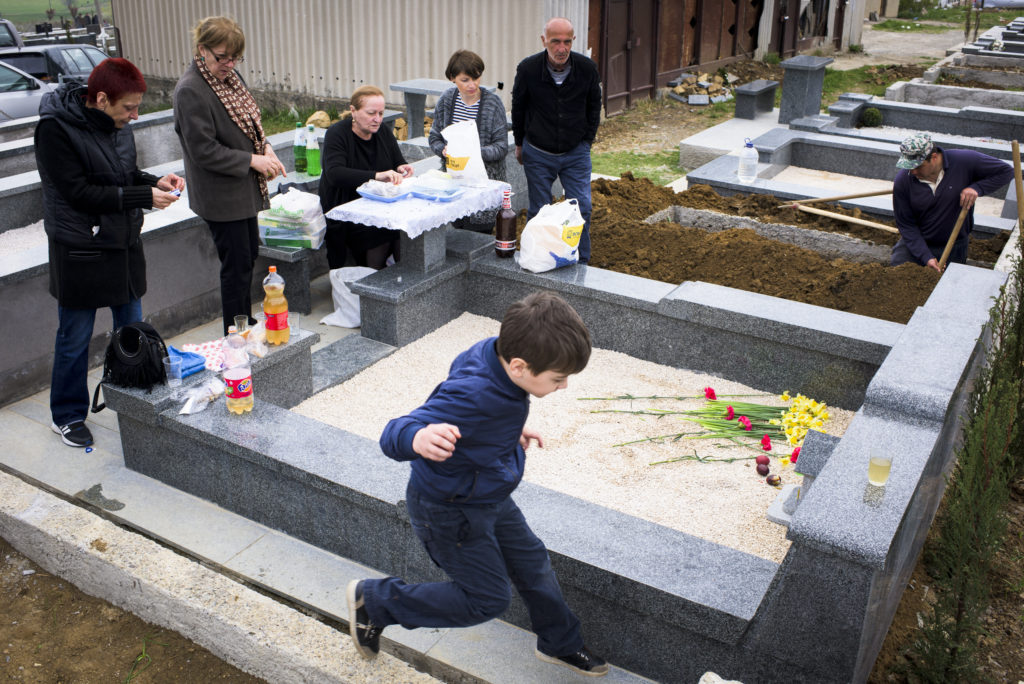
A family gathers to celebrate the departed and have a meal in Mukhatgverdi Cemetery on Monday, April 9, 2018 in Tbilisi, Georgia.
In the United States, Thanksgiving notoriously snarls traffic throughout the country, as people take to the road to visit their far-flung family members. In Georgia, the rugged Caucasus country nestled between Russia and Turkey, Easter is much the same, with one difference: the family members people are traveling long distances to visit are no longer living.
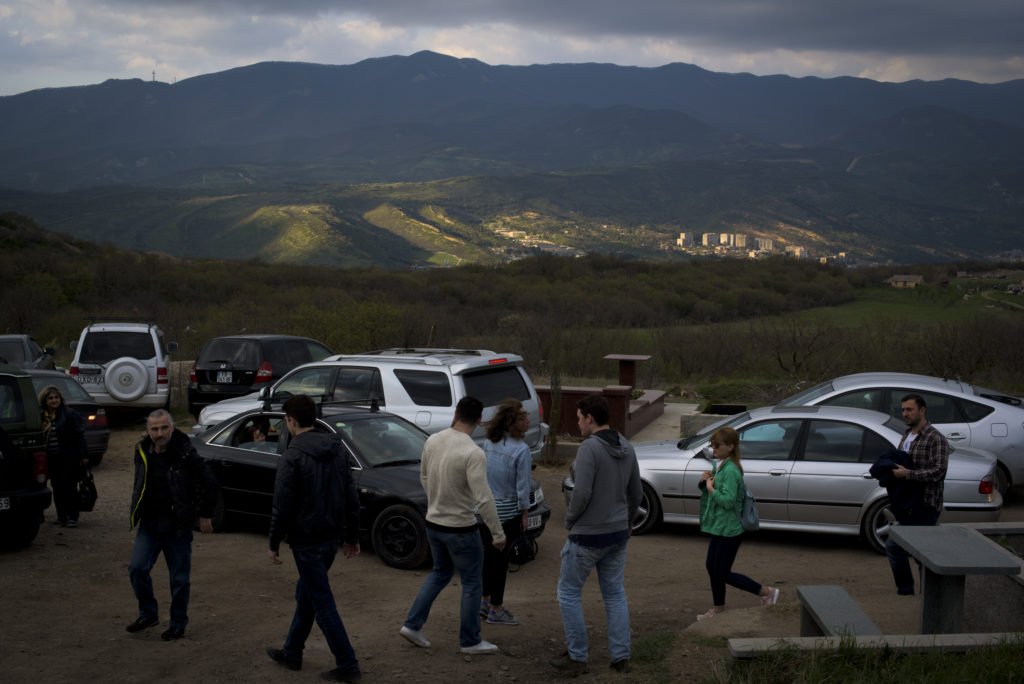
Light illuminates the opposite side of the valley at Mukhatgverdi graveyard on April 9, 2018 in Northern Tbilisi, Georgia.
Every year, thousands make pilgrimage to the gravesites of their ancestors to leave offerings, commune, and share a meal. Traffic jams are common in Georgia’s ancient graveyards on the Monday following Easter (celebrated according to the Orthodox/Julian calendar).
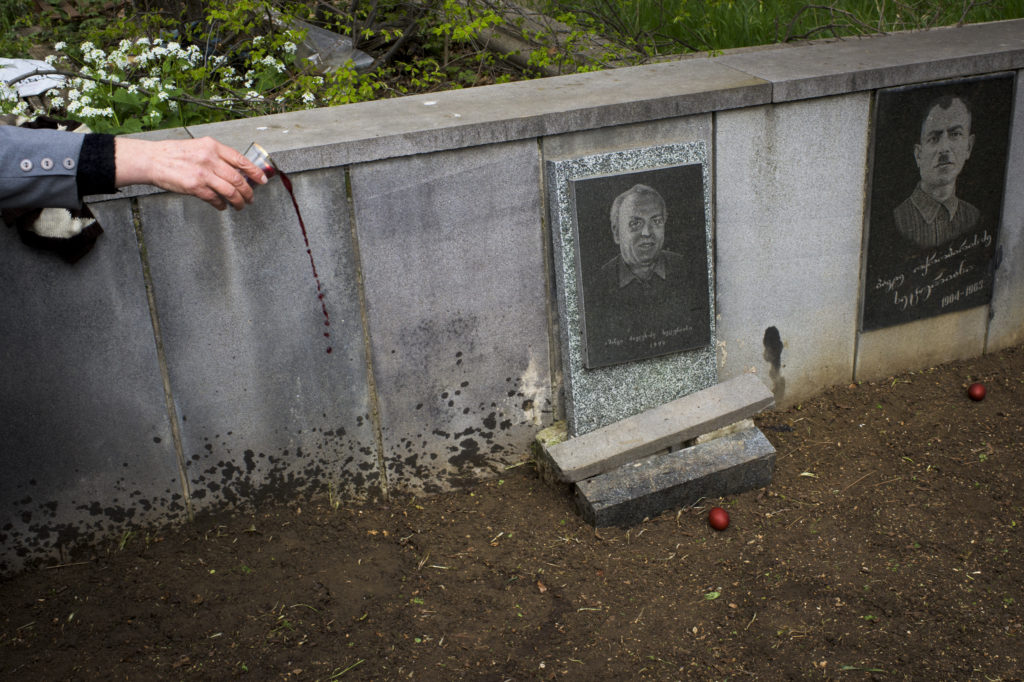
Wine is spilled on a grave in remembrance of the dead in Mukhatgverdi graveyard on April 9, 2018 in Tbilisi, Georgia.
Visiting graves is such an important part of Georgian culture that many gravesites incorporate simple metal tables next to the plot. Most Easter spreads feature red-dyed eggs, which symbolize the rebirth of Christ, and paska, sweet bread that incorporates ingredients like butter and eggs that can’t be eaten during Lent. Homemade wine and Georgia’s robust national liquor, chacha, are abundant, and are poured on graves following toasts to the departed. Sweets, khachupuri (the Instagram-famous cheesy bread) and grilled meats round out the feasts.
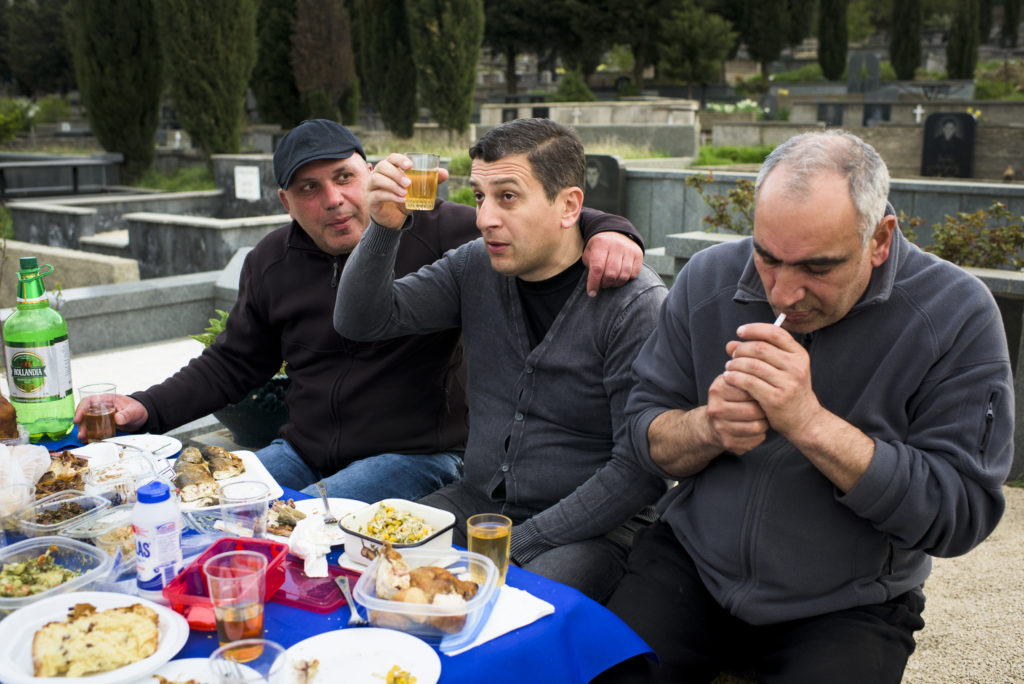
Girogi Bregvadeze, center, toasts the departed at the grave of Irakli Ejabidze, with Alexandre Bodbeli, left, and Nukri Gamtendaze, right, at Mukhatgverdi cemetery on April 9, 2018 in Tbilisi, Georgia.
Liana Elikashvili, who was visiting her father’s grave on Easter Sunday because she had to work the day after Easter, noted that her father “loved candy.” “He also loved vodka, but I don’t have any.”
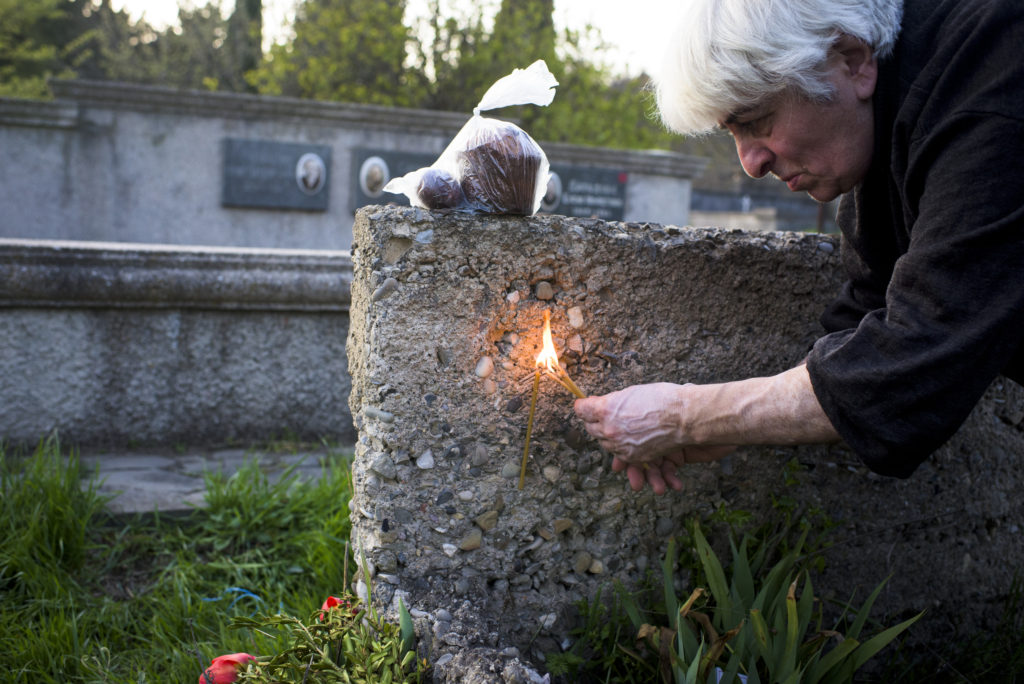
Liana Elikashvili lights candles at her father’s grave at Mukhatgverdi on Sunday, April 8, 2018 in Tbilisi, Georgia.
The cemeteries themselves reflect Georgia’s complicated, cliché-defying diversity. Western Christian Crosses and Orthodox Crosses with their 3 crossbars are plentiful, but just as numerous are the indigenous, drooping crosses of St. Nino, who introduced Christianity to Georgia in the 4th Century. Most graves from the 1900s feature the Cyrillic alphabet, a hallmark of Soviet-era efforts at homogenization, while more recent tombstones feature flowing Georgian lettering. And ever since Georgia fought a bloody war with Abkhazia, families have struggled with how to visit ancestors buried in the region. Once its own Soviet State, it was folded into the Georgian SSR in 1931 and, following an armed conflict in the early 1990s, now exists as a mostly-unrecognized autonomous republic.
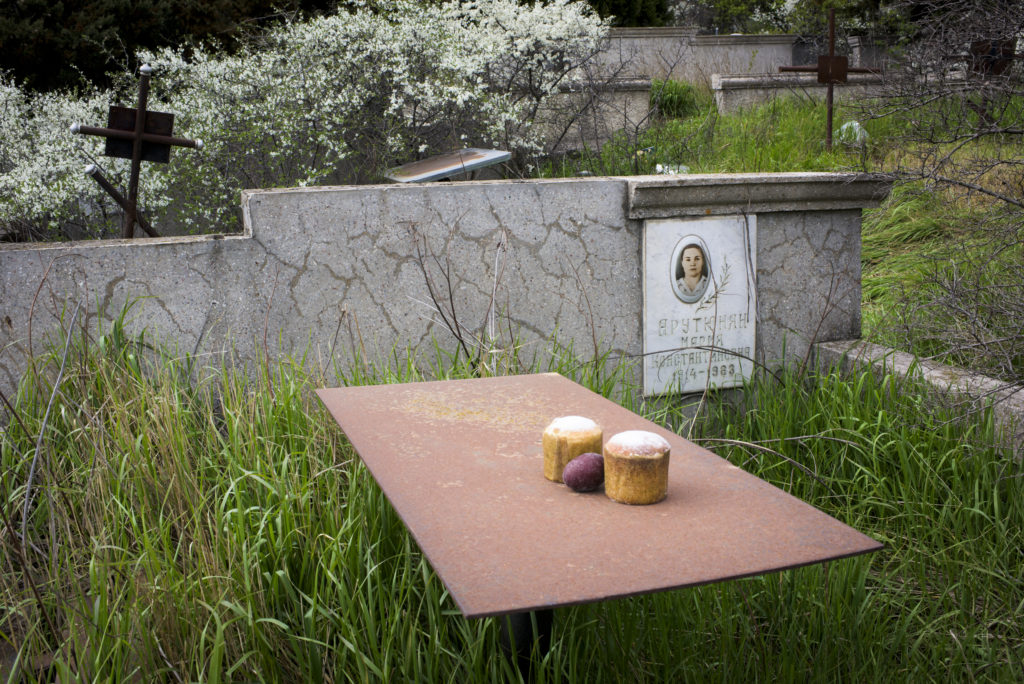
Two pieces of Paska, and a red-dyed Easter egg, are seen on a table at an overgrown grave at Mukhatgverdi cemetery on Monday, April 9, 2018 in Tbilisi Georgia.
Nato Kapoliani was at her plot at Mukhatgverdi Cemetery on the outskirts of Tbilisi, and said she’d considered exhuming and moving her ancestors from Abkhazia so that they can be visited more easily. Ultimately she decided against it because she felt it would be tacitly condoning what most Georgians consider an illegal occupation. Nevertheless, imagining the graves in Abkhazia, “so lonely and abandoned,” is a source of profound sadness for her.
“Whenever we see an abandoned grave, we leave a small piece of paska or something…the point is we don’t respect only our ancestors, but all of them. When we die we go to live another life,” explained Malkhaz Solashvili who was visiting his ancestors nearby.
“I feel I’m coming home when I come here,” explained another visitor.
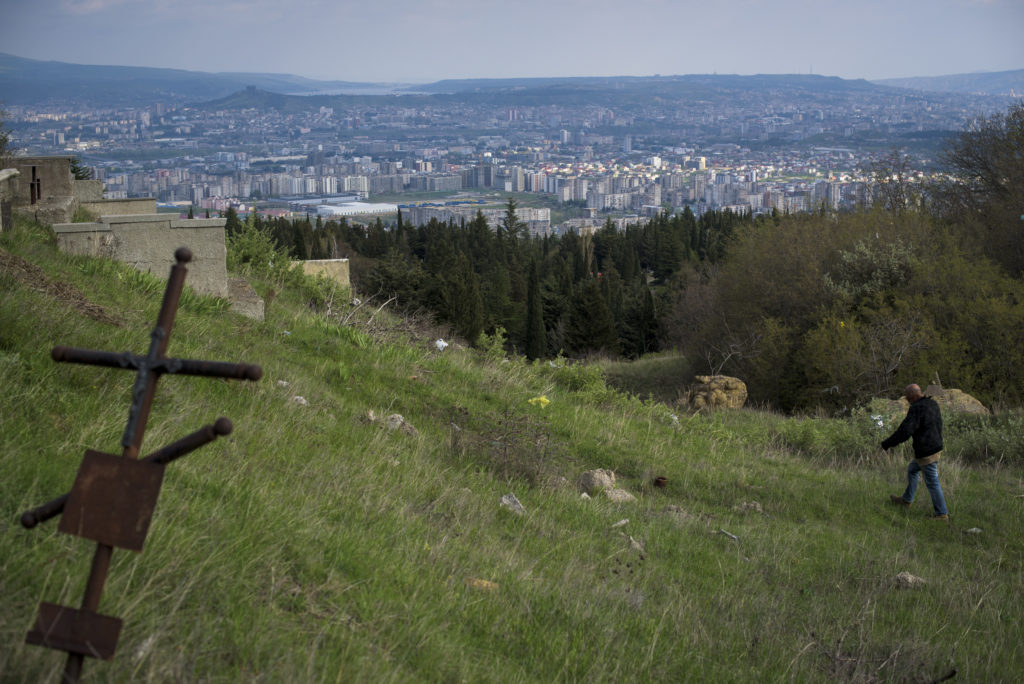
A man crosses a grassy hillside at Mukhatgverdi cemetery on Monday, April 9, 2018 in Tbilisi, Georgia.
The tradition of visiting graves after Easter straddles religious and cultural lives of Georgians, says theologian Mirian Gamrekelaschwili, somewhat akin to Mexico’s Día de los Muertos. While research on the topic is scarce, Levan Gigineishvili, a professor at the Institute of Classics at the Tbilisi State University, posits that the tradition naturally evolved from the village church’s proximity to the graveyards – following lengthy Easter services that lasted until the early-morning hours, parishioners would find their way to the nearby graves of their ancestors to leave red-dyed eggs that had been blessed by the priest.
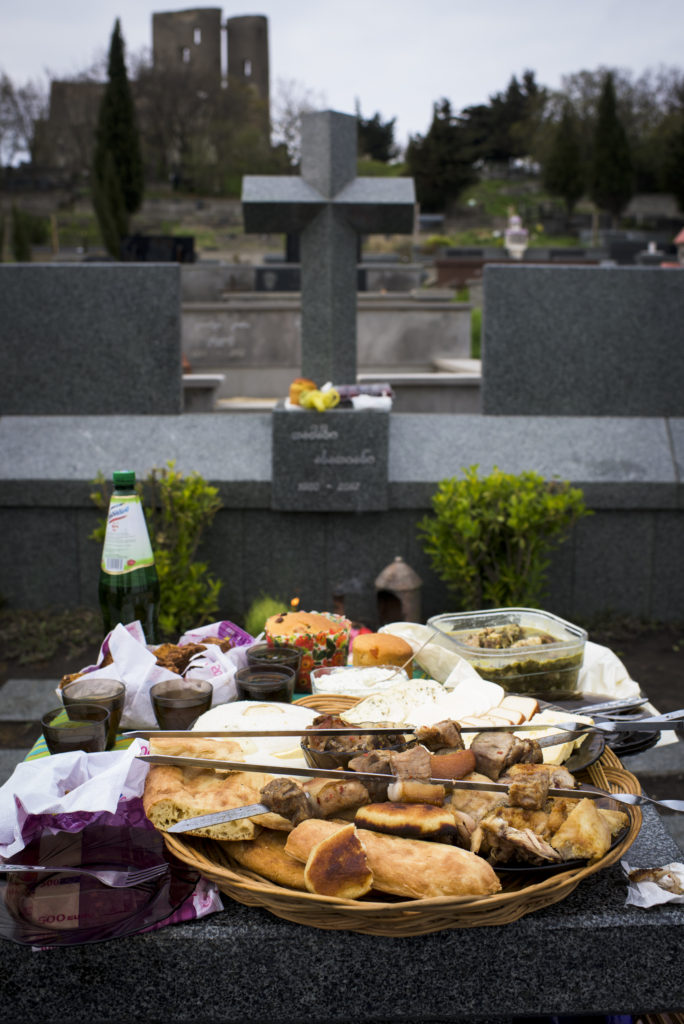
A spread of food is seen in front of a grave at Mukhatgverdi cemetery on Monday, April 9, 2018 in Tbilisi, Georgia.
In general, the Georgian Church has urged people to delay visiting graves as not to tarnish the celebration of Christ’s resurrection with painful memories of death. “Yet, the Church’s admonition remains an admonition by and large neglected by the people,” notes Gigineishvili, who frames the tradition by explaining that “it is only natural and theologically correct to make the departed co-celebrants of the glorious victory of Christ over sin and death.”
***
I spent several days in the graveyards around Tbilisi, Georgia in 2018 to explore this tradition that had fascinated me for years. Vake Cemetery is situated in a posh neighborhood, with smooth marble tombstones. Kukia is ancient and crumbling, with its winding paths snaking between sagging graves. But mostly I roamed massive Mukhatgverdi, on the outskirts of town, where a small section is reserved for service members. A mother visiting the grave of her soldier son apologized for the spread at her son’s plot, which she deemed inadequate. Guests are sent by God, goes the oft-repeated Georgian refrain, but I never expected that sentiment to extend to the intimate moments spent with deceased family members.
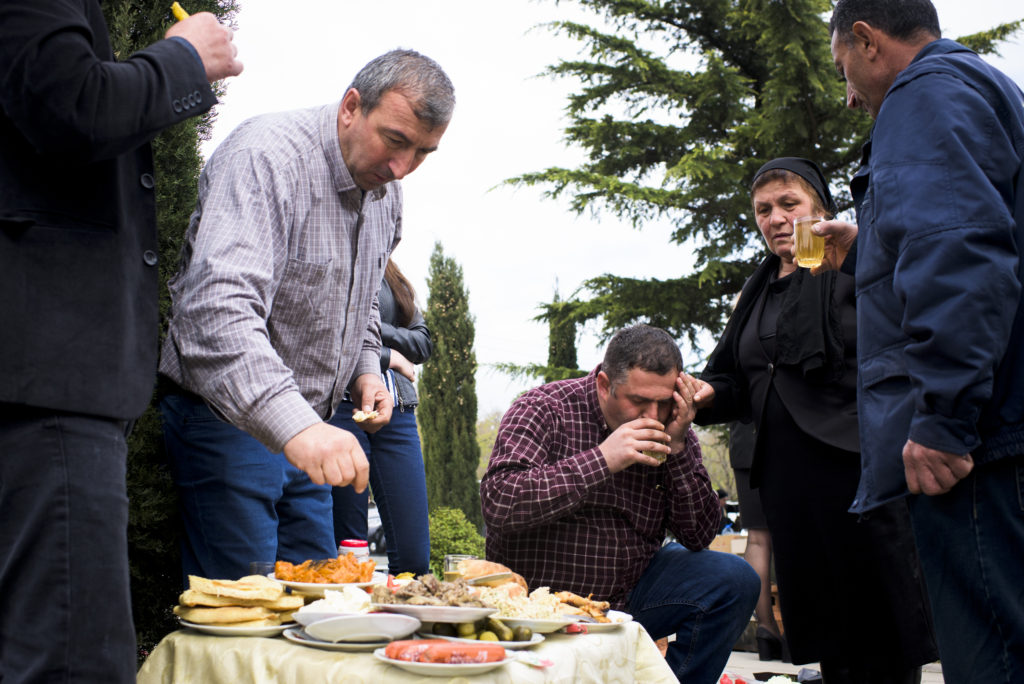
The family of Roman Zoidze, a 20-year old solider who was killed in the 2008 flare-up of the Abkhazia conflict, including Fridon Zoidze, Roman’s brother, center, kneeling, and Maro Zoidze, his mother, dressed in black, gathers to celebrate the departed in Mukhatgverdi Cemetery on Monday, April 9, 2018 in Tbilisi, Georgia.
At the first grave I visited, I was implored by those in attendance to feast and drink with them. They gestured with a giant jug of chacha, assuring me they had a copious supply and that I wasn’t imposing.
“If I drink 5 liters of chacha, I’ll die,” I protested.
“That’s fine,” they cheerfully replied, gesturing to the adjacent plot, “we’ll bury you here.”
Mariam Kiparoidze contributed reporting to this story.
Pete Kiehart is an American visual journalist based nominally in Paris, France. A deep passion for visual storytelling underlies his work, which runs the gamut from conflict photography to sports, portraiture, and conceptual projects. After working as a producer and editor at Reportage by Getty Images, he moved to San Francisco, where he was Director of Photography at ONCE Magazine and a hybrid editor and photographer for the San Francisco Chronicle. He left the Chronicle in 2015 to live in and cover the conflict in Ukraine on a freelance basis, and relocated to Paris in 2017. Pete holds a Bachelor’s Degree in Public Policy Studies from Duke University.
***
Published with support from the Henry R. Luce Initiative on Religion in International Affairs.